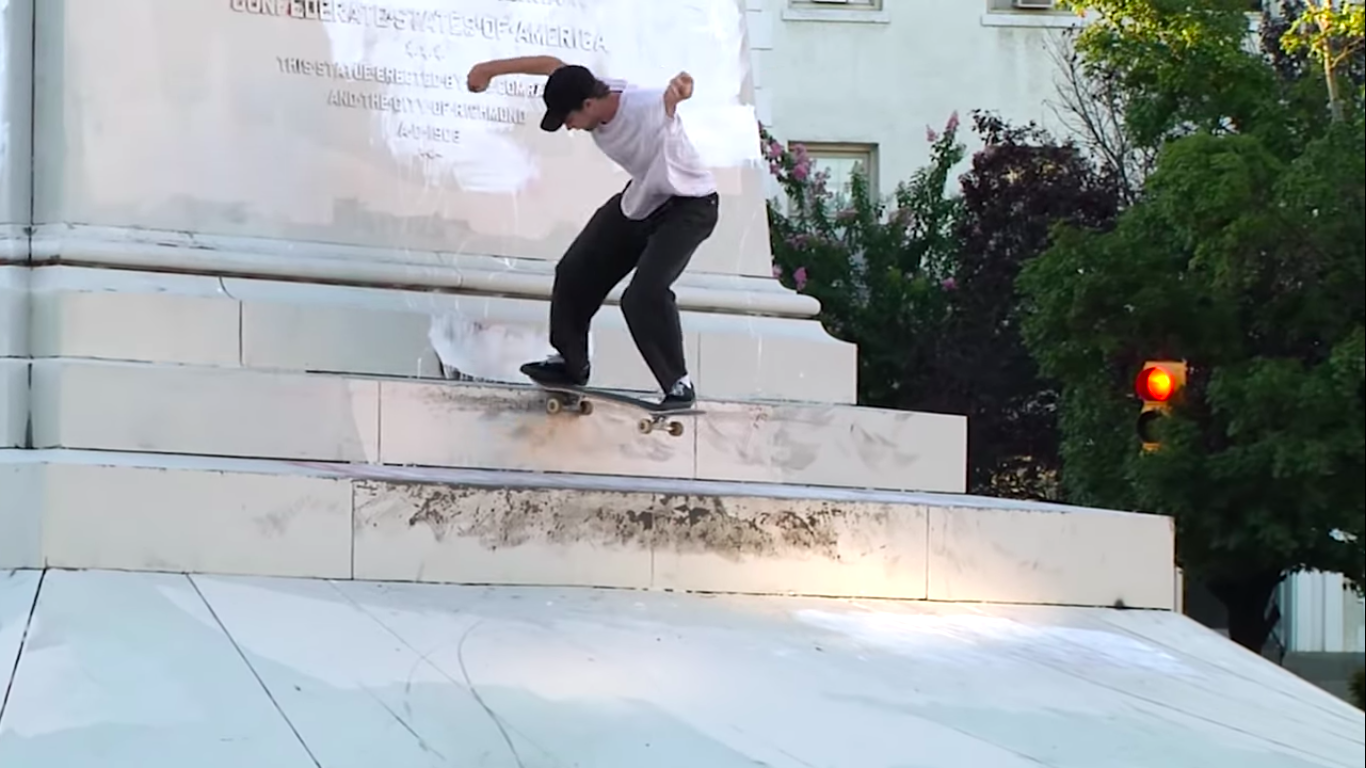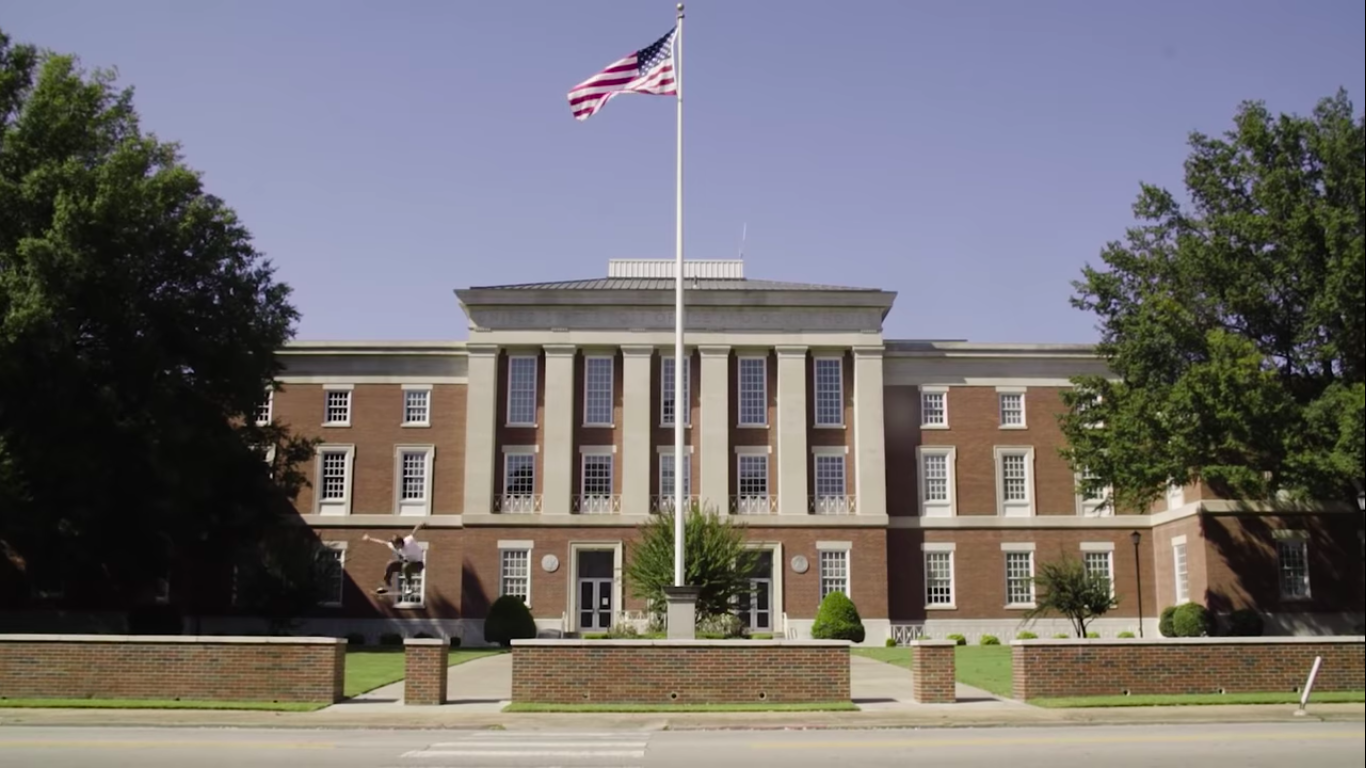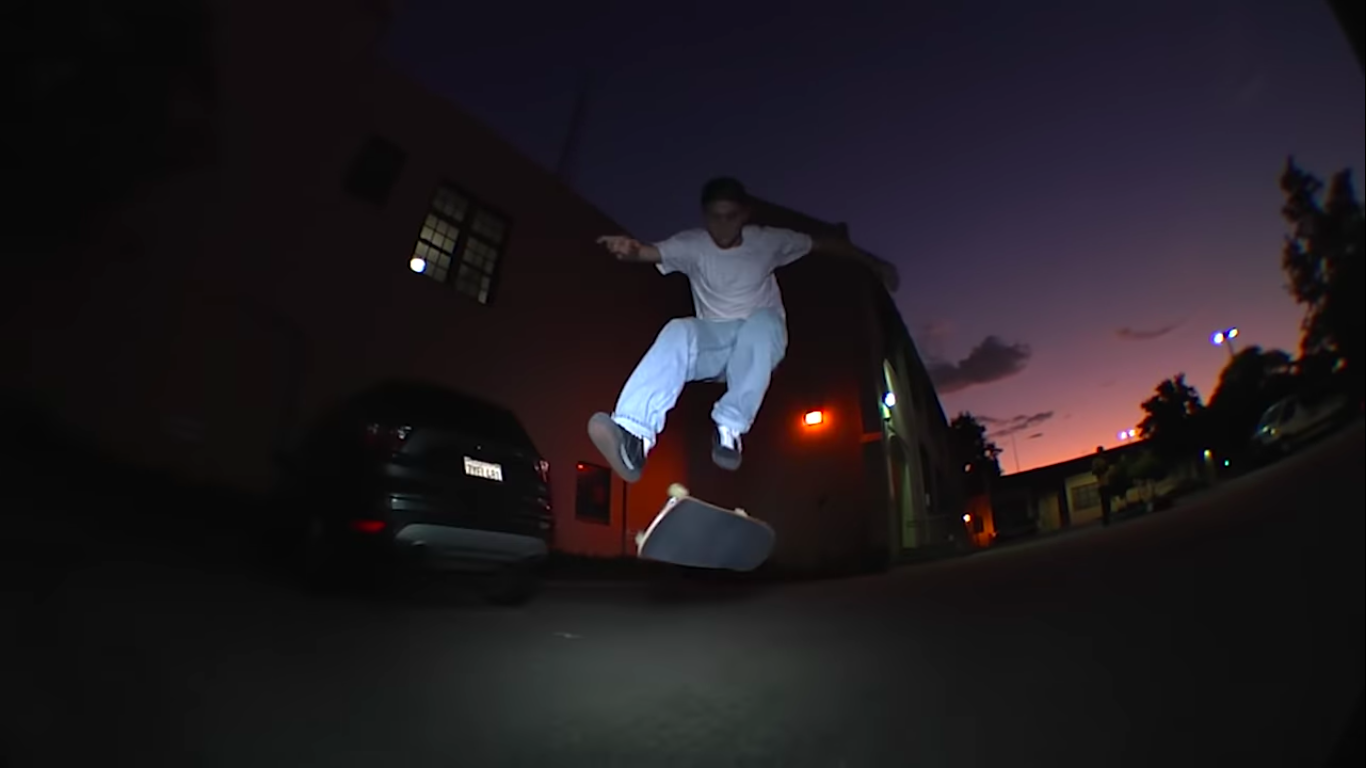CALEB: A Southern Gothic Welcome Clip
Part of the charm we experience from watching skateboard videos can be attributed to the trope of the lovable childhood scamp. Even if the skater is in their 20s (or 30s, or even, sometimes, possibly, if you squint, 40s), their presence recalls any of a handful of archetypes, mixing together Horatio Alger’s bootstrappers, Dickens’ street urchins, Mark Twain’s pair of river rats, as well as more modern examples, like JD Salinger’s existential Catcher, Raymond Queneau’s New Wave Zazie, and even the devil-may-care Nietzschean anti-hero, Bart Simpson. What these characters tend to have in common is that they are all unburdened by the past—or, as all teenagers do, act with abandon toward the future—their haste, angst, innocence, and not just a little ennui having primed them to embody the enthusiasms and pitfalls of a given generation.
While these types of characters usually guide us on an adventure of some kind, their defining mobility seems poorly suited to the past 12 months, during which the pandemic ground the world to a halt (sort of). Yet, Caleb McNeely and his collaborators at HUF, seem to have taken up the challenge with CALEB, wisely invoking the fleetingness of youth to make sense of, and bring some urgency to the extended doldrums of the ongoing COVID-19 crisis. Indeed, from the start, we do not directly witness a global public health disaster, but rather, via the video’s languorous Southern imagery, accompany the skater on an extended summer break, partaking of the same riverside swimming holes, cliffside views, and golden sunflowers, the latter of which, in one 35mm photograph, vibrate with a palpable inner life. That youth is in bloom, and responsibility is on hold carries over into images of McNeely, as well. He is our eternal Huck Finn, pictured either behind the wheel, mobile, unencumbered, on the road, or else wandering in the shade of a highway overpass, finding in this hiding spot what most people have craved for the past 12 months—freedom and escape.
While these types of characters usually guide us on an adventure of some kind, their defining mobility seems poorly suited to the past 12 months, during which the pandemic ground the world to a halt (sort of). Yet, Caleb McNeely and his collaborators at HUF, seem to have taken up the challenge with CALEB, wisely invoking the fleetingness of youth to make sense of, and bring some urgency to the extended doldrums of the ongoing COVID-19 crisis. Indeed, from the start, we do not directly witness a global public health disaster, but rather, via the video’s languorous Southern imagery, accompany the skater on an extended summer break, partaking of the same riverside swimming holes, cliffside views, and golden sunflowers, the latter of which, in one 35mm photograph, vibrate with a palpable inner life. That youth is in bloom, and responsibility is on hold carries over into images of McNeely, as well. He is our eternal Huck Finn, pictured either behind the wheel, mobile, unencumbered, on the road, or else wandering in the shade of a highway overpass, finding in this hiding spot what most people have craved for the past 12 months—freedom and escape.
The same carefree ethos can be felt throughout the video: with work on hold, and spots abandoned, there seems to be nothing else to do, but skate. Along with the normal out-of-the-way spots, McNeely and his pals extend their vision to those places that had previously been deemed unskatable or a bust, like the Brutalist federal buildings in DC that play host to a miraculous pair of quick-footed combos. Yet, that same incredulity and sense of unimaginable opportunity eventually take on an erie sense of suspension: a granite-covered plaza is the site of surreal beauty when McNeely glides through a fakie nosegrind revert followed by a front blunt kickflip on respective ledges. Yet, with nobody around, the clip is uncanny, its underlying dread also making us aware of certain losses, such as the security guard that implicates our mischievous vocation within a wider social contract, or the local color of an office worker who we would expect to sit on the second bench, and, without fail, refuse to move for the duration of her 15-minute smoke break.
Obviously there are limitations to the youthful archetype’s ability to address the breadth of the pandemic: when McNeely presses a frontside noseslide to fakie on the vandalized pedestal of Richmond’s statue of Confederate General J.E.B. Stuart, the clip feels dangerously ahistorical, taking for granted the protests and public pressure that lead to the monument’s removal, and which only incidentally freed up the space for skaters, as well. Yet, and I know this is a stretch, the videomaker’s decision to crop out the statue itself makes me give them the benefit of the doubt that they are aware of its racist legacy (otherwise, guys, I have questions about why you included it...).
Obviously there are limitations to the youthful archetype’s ability to address the breadth of the pandemic: when McNeely presses a frontside noseslide to fakie on the vandalized pedestal of Richmond’s statue of Confederate General J.E.B. Stuart, the clip feels dangerously ahistorical, taking for granted the protests and public pressure that lead to the monument’s removal, and which only incidentally freed up the space for skaters, as well. Yet, and I know this is a stretch, the videomaker’s decision to crop out the statue itself makes me give them the benefit of the doubt that they are aware of its racist legacy (otherwise, guys, I have questions about why you included it...).
Overall, though, McNeely is a great guide, unshy about his excitement at a time when such necessary expressions of humanity could feel inappropriate, or simply hard to muster. Particularly in its invocation of the Southern Gothic, the video exposes a richness and depth out of the pandemic’s miasma of confusion, with the scenery’s sense of fatefulness always contrasted by McNeely’s ease on a skateboard. Such tension comes through in a moody, sunset clip. The soft, clementine glow of a soda lamp provides the backdrop for a bump to bar, which McNeely ollies, lancing a curb with his back truck on the way down. It’s a banger, but as the filmer gradually overtakes his subject, we are suddenly forward moving, but backwards looking, beholding one last flatground 360 flip at the exact moment the day expires.
Yes, my pandemic gone by, I’ll miss it so (I suppose). McNeely’s part shows how, for skaters at least, unemployment was just more time to skate, with thousands of kids suddenly getting sponsored by the Federal Government. Yet, in invoking the stasis of unemployment, or the slowness of summer, the video reminds us that such grace periods are temporary. It also calls to mind those paralyzing moments of indecision, when doing the right thing felt so unclear. Yet, the video’s choice of country music soundtrack reinforces the fact that time still passes. In Robert Lester Folsom’s “See You Later, I’m Gone,” we hear the plaintive longing for home and normalcy brought on by the passage of summer into fall. The mood it sets can be a little idealistic and indulgent—similarly, McNeely never seems to wear a mask, and that’s a problem. But, as evidenced in the skater’s ender, the same heartrending lyricism, and sense of expiration comes across in the skating.
Yes, my pandemic gone by, I’ll miss it so (I suppose). McNeely’s part shows how, for skaters at least, unemployment was just more time to skate, with thousands of kids suddenly getting sponsored by the Federal Government. Yet, in invoking the stasis of unemployment, or the slowness of summer, the video reminds us that such grace periods are temporary. It also calls to mind those paralyzing moments of indecision, when doing the right thing felt so unclear. Yet, the video’s choice of country music soundtrack reinforces the fact that time still passes. In Robert Lester Folsom’s “See You Later, I’m Gone,” we hear the plaintive longing for home and normalcy brought on by the passage of summer into fall. The mood it sets can be a little idealistic and indulgent—similarly, McNeely never seems to wear a mask, and that’s a problem. But, as evidenced in the skater’s ender, the same heartrending lyricism, and sense of expiration comes across in the skating.
Set against a closed-down, neo-classical high school, McNeely squares up on the chest high parapet that forms the front-most boundary of the grounds, intent to ollie a successive pair of gaps in the wall. An American flag still flies on the flagpole, though it’s virtually impossible to tell what day of the week it is, merely that it is a beautifully sunny afternoon. There are no students milling about. At first, a tracking shot condenses the languorousness of this dog day, sharpening our attention via McNeely’s intense focus, and the urgency speed brings to the clip. But with a second, stationary angle, the intensity is slowed back down, situating McNeely as but one element in a larger composition, put in perspective before this enveloping landscape. The scene suggests some kind of metaphor: the pandemic, America, capital “H” History. To me, it is refreshing to see such a fully fledged character galvanize the past 12 months, in spite of all the ambiguity. Though it clearly has its faults, and borders on the sentimental, CALEB nonetheless puts forth images of skating utterly unique to the present, helping us to appreciate that even this challenging moment will, someday, be gone. •••



